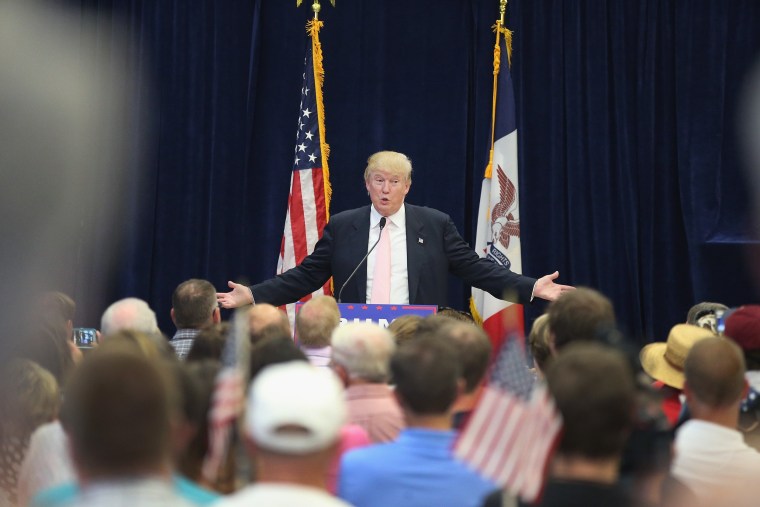Donald Trump is riding high in the polls in the key early primary states of Iowa and New Hampshire, but a closer look inside the numbers show that the Republican mogul is drawing support from two very different groups of voters, according to the latest NBC News-Marist public opinion polls released Sunday.
One group is underpinned by older voters who are heavily Republican and conservative (in New Hampshire, where he leads the field). The other is driven by younger voters who are more likely to describe themselves as independent and moderate (in Iowa, where he’s in second).
The fact that Trump is appealing to both of them is reminder that Republican voters can look very different from state to state and that we are in the very early stages of figuring out the Republican field. On the basic level, the Trump contingents in New Hampshire and Iowa had very different reactions to the candidate’s comments on Sen. John McCain, but there are more fundamental differences down the line.
In both states the NBC News-Marist poll was conducted before and after the Trump-McCain flap and differences were remarkable. In New Hampshire, Mr. Trump saw a 12-point decline in support – from 26% before to 14% after. But in Iowa, Mr. Trump actually saw a small increase – from 18% supporting him before to 19% after.
Those differences may have to do with the partisan make-up of Mr. Trump’s supporters in both states.
Trump leads the GOP field in New Hampshire in this poll primarily due to his strong support among self-described Republicans. In this poll he carries 21% of the vote from New Hampshire Republicans, next highest on the list is former Florida Jeb Bush at 14% – a seven-point gap.
He also leads by a wide-margin among people who say they are “conservative or very conservative” – carrying 25% of their support. Among “moderates” he’s at 11% support, a distant second to Bush at 21%.

But in Iowa, Trump is in second place among Republicans, with 16%, to Wisconsin Gov. Scott Walker at 18%. Meanwhile, he is tied with Walker for the independent vote at 16%. And Trump’s Iowa voters are also much more likely to be moderates – his Iowa “moderate” and “conservative” numbers are flipped from New Hampshire.

Another big difference: The age of Trump-ites in the two states.
In New Hampshire, Trump’s lead comes from a large edge among voters 45 or older. He captures 22% of their vote, while Bush is in second places with those voters at 12% – a 10-point lead.
In Iowa, though, the key to Trump’s strength is people who are younger than 45. He wins 26% of those voters – Walker and Bush are tied for a distant second at 13%.
Some differences are expected in polls conducted in different states, but these divides are especially noteworthy and different from other 2016 potentials.
To be fair, there are also some commonalities in Trump’s supporters in the two states. In both he tends to do better with those who do not have a college education.
In New Hampshire he dominates with that group, winning 26% of their support. He also leads with college graduates in the state but he only wins 16% of their support. In Iowa, Trump is tied with Walker for the lead among those who do not have a college education, both at 18%. He wins only 16% of supporters who are college graduates.
And one other interesting similarity, in both states Trump is a decisive winner among those who were reached on cellphones.
But going by these numbers, the differences in the New Hampshire and Iowa Trump supporters outweigh the similarities and that raises some questions. Among them, does one state’s Trump group represent the “real” Trump core group? Are the differences a function of state electorates that simply radically different? Or is the real impact of the media-driven Trump phenomenon still largely unformed in the states that cast the first votes in the GOP nominating contests?
